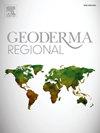从森林到农田:追踪半干旱栎林土壤质量的时间序列变化
IF 3.3
2区 农林科学
Q2 SOIL SCIENCE
引用次数: 0
摘要
土壤质量评价对可持续发展至关重要,因为土壤在生态系统中发挥着基础性作用,影响着生境特征、生态系统稳定性和生物地球化学循环。研究了1985 - 2021年伊朗西部半干旱栎林生态系统土壤质量指数(SQI)随土地利用变化的时空变化特征。采用条件拉丁超立方体采样法采集了150个表层土壤样品(0 ~ 30 cm)。对样品的理化性质进行分析,采用综合加权指数法确定SQI。此外,各种环境变量——包括地质图、地形属性以及与河流和道路的接近程度——也被纳入分析。利用1985年、2000年、2010年和2021年的Landsat 8影像生成植被指数和土地利用时序图,支持SQI空间预测。随机森林(RF)模型用于模拟和绘制SQI和土地利用随时间的变化。RF模型显示出较高的准确性,土地利用预测的Kappa指数为92.3% - 96.0%,SQI预测的R2值为0.80-0.88。空间模拟结果确定了影响SQI的四个关键环境因子:收敛指数、矢量地形崎岖度、与河流的距离和Landsat波段的最小噪声分数。对1985年至2021年SQ变化的分析显示,SQI类别在不同土地利用中的分布发生了重大变化。森林、农用地、牧场低sq面积分别增加20.3%、22.6%和29.7%,表明土壤普遍退化。值得注意的是,在研究区中部,牧地和农用地扩大,sqi呈下降趋势,进一步反映了与这些土地利用相关的土壤退化。这项研究强调了持续监测SQ和可持续土地管理措施以减轻半干旱生态系统土壤退化的迫切需要。调查结果强调了土地利用变化对土壤健康的有害影响,特别是将森林转变为农业用地,这造成了严重的土壤退化和生物多样性丧失。实施保护战略,如重新造林和改进农业做法,对于保持该地区的土壤质量至关重要。本文章由计算机程序翻译,如有差异,请以英文原文为准。
From forest to farmland: Tracking time series variations in soil quality in semiarid oak forest
Assessing soil quality (SQ) is essential for sustainable development, as soils play a fundamental role in ecosystems, influencing habitat characteristics, ecosystem stability, and biogeochemical cycles. This study examines the spatio-temporal variations of the Soil Quality Index (SQI) in response to land use changes within a semi-arid oak forest ecosystem in western Iran from 1985 to 2021. To conduct the research, 150 surface soil samples (0–30 cm) were collected using the conditional Latin hypercube sampling method. The physical and chemical attributes of these samples were analyzed to determine the SQI using the Integrated Weighted Index method. Additionally, various environmental variables—including geological maps, topographic attributes, and proximity to streams and roads—were incorporated into the analysis. Time series maps of vegetation indices and land use were generated using Landsat 8 imagery (covering 1985, 2000, 2010, and 2021) to support SQI spatial prediction. The Random Forest (RF) model was employed to model and map both SQI and land use changes over time. The RF model demonstrated high accuracy, achieving a Kappa index of 92.3 %–96.0 % for land use predictions and an R2 value of 0.80–0.88 for SQI predictions. Spatial modeling results identified four key environmental factors influencing SQI: convergence index, vector terrain ruggedness, distance from streams, and minimum noise fraction of Landsat bands. Analysis of SQ changes from 1985 to 2021 revealed a significant shift in the distribution of SQI classes across various land uses. The proportion of low-SQ areas increased by 20.3 % in forests, 22.6 % in agricultural lands, and 29.7 % in rangelands, indicating widespread soil degradation. Notably, in the central part of the study area—where rangeland and agricultural lands have expanded—SQI exhibited a downward trend, further reflecting soil deterioration associated with these land uses. This research highlights the critical need for ongoing SQ monitoring and sustainable land management measures to mitigate soil degradation in semi-arid ecosystems. The findings emphasize the detrimental impact of land use changes on soil health, particularly the conversion of forests to agricultural lands, which has contributed to severe soil degradation and biodiversity loss. Implementing conservation strategies, such as reforestation and improved agricultural practices, is essential to preserving soil quality in the region.
求助全文
通过发布文献求助,成功后即可免费获取论文全文。
去求助
来源期刊

Geoderma Regional
Agricultural and Biological Sciences-Soil Science
CiteScore
6.10
自引率
7.30%
发文量
122
审稿时长
76 days
期刊介绍:
Global issues require studies and solutions on national and regional levels. Geoderma Regional focuses on studies that increase understanding and advance our scientific knowledge of soils in all regions of the world. The journal embraces every aspect of soil science and welcomes reviews of regional progress.
 求助内容:
求助内容: 应助结果提醒方式:
应助结果提醒方式:


